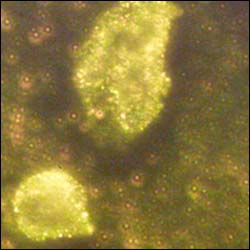Gold Nanoparticles May Simplify Cancer Detection

Gold nanoparticles stick to cancer cells and make them shine.
Binding gold nanoparticles to a specific antibody for cancer cells could make cancer detection much easier, suggests research at the Georgia Institute of Technology and the University of California at San Francisco (UCSF). The report is published online as an ASAP article in the journal Nano Letters.
“Gold nanoparticles are very good at scattering and absorbing light,” said Mostafa El-Sayed, director of the Laser Dyanamics Laboratory and chemistry professor at Georgia Tech. “We wanted to see if we could harness that scattering property in a living cell to make cancer detection easier. So far, the results are extremely promising.”
Many cancer cells have a protein, known as Epidermal Growth Factor Receptor (EFGR), all over their surface, while healthy cells typically do not express the protein as strongly. By conjugating, or binding, the gold nanoparticles to an antibody for EFGR, suitably named anti-EFGR, researchers were able to get the nanoparticles to attach themselves to the cancer cells.
“If you add this conjugated nanoparticle solution to healthy cells and cancerous cells and you look at the image, you can tell with a simple microscope that the whole cancer cell is shining,” said El-Sayed. “The healthy cell doesn’t bind to the nanoparticles specifically, so you don’t see where the cells are. With this technique, if you see a well defined cell glowing, that’s cancer.”
In the study, researchers found that the gold nanoparticles have 600 percent greater affinity for cancer cells than for noncancerous cells. The particles that worked the best were 35 nanometers in size. Researchers tested their technique using cell cultures of two different types of oral cancer and one nonmalignant cell line. The shape of the strong absorption spectrum of the gold nanoparticles are also found to distinguish between cancer cells and noncancerous cells.
What makes this technique so promising, said El-Sayed, is that it doesn’t require expensive high-powered microscopes or lasers to view the results, as other techniques require. All it takes is a simple, inexpensive microscope and white light.
Another benefit is that the results are instantaneous. “If you take cells from a cancer stricken tissue and spray them with these gold nanoparticles that have this antibody you can see the results immediately. The scattering is so strong that you can detect a single particle,” said El-Sayed.
Finally, the technique isn’t toxic to human cells. A similar technique using artificial atoms known as Quantum Dots uses semiconductor crystals to mark cancer cells, but the semiconductor material is potentially toxic to the cells and humans.
“This technique is very simple and inexpensive to use,” said El-Sayed. “We think it holds great promise in making cancer detection easier, faster and less expensive.”
The research team consisted of El-Sayed, along with his son Ivan El-Sayed, head and neck surgeon at the UCSF Comprehensive Cancer Center and Tech graduate student Xiaohua Huang.
Media Contact
More Information:
http://www.icpa.gatech.eduAll latest news from the category: Life Sciences and Chemistry
Articles and reports from the Life Sciences and chemistry area deal with applied and basic research into modern biology, chemistry and human medicine.
Valuable information can be found on a range of life sciences fields including bacteriology, biochemistry, bionics, bioinformatics, biophysics, biotechnology, genetics, geobotany, human biology, marine biology, microbiology, molecular biology, cellular biology, zoology, bioinorganic chemistry, microchemistry and environmental chemistry.
Newest articles

Properties of new materials for microchips
… can now be measured well. Reseachers of Delft University of Technology demonstrated measuring performance properties of ultrathin silicon membranes. Making ever smaller and more powerful chips requires new ultrathin…

Floating solar’s potential
… to support sustainable development by addressing climate, water, and energy goals holistically. A new study published this week in Nature Energy raises the potential for floating solar photovoltaics (FPV)…

Skyrmions move at record speeds
… a step towards the computing of the future. An international research team led by scientists from the CNRS1 has discovered that the magnetic nanobubbles2 known as skyrmions can be…





















